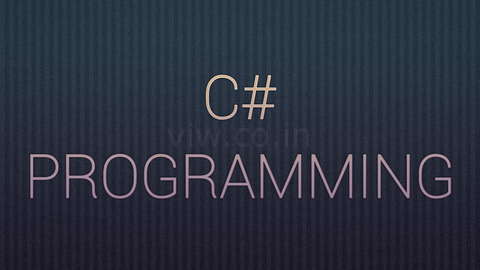
C# Progamming
Microsoft .NET Framework
The Microsoft .NET Framework is a software framework that can be installed on computers running Microsoft Windows operating systems. It includes a large library of coded solutions to common programming problems and a common language infrastructure that manages the execution of programs written specifically for the framework. The .NET Framework supports multiple programming languages in a manner that allows language interoperability, whereby each language can utilize code written in other languages; in particular, the .NET library is available to all the programming languages that .NET encompasses.
The framework's Base Class Library provides a large range of features including user interface, data access, database connectivity, cryptography, web application development, numeric algorithms, and network communications. The class library is used by programmers, who combine it with their own code to produce applications.
Programs written for the .NET Framework execute in a software environment that manages the program's runtime requirements. Also part of the .NET Framework, this runtime environment is known as the Common Language Runtime (CLR). The CLR provides the appearance of an application virtual machine so that programmers need not consider the capabilities of the specific CPU that will execute the program. The CLR also provides other important services such as security, memory management, and exception handling. The class library and the CLR together constitute the .NET Framework.
The .NET Framework is a Microsoft offering and is intended to be used by most new applications created for the Windows platform. In order to be able to develop and not just run applications for the Microsoft .NET Framework 4.0, it is required to have Microsoft's SDK for Windows 7 or .NET Framework 4 (or newer) or Visual Studio 2010 installed on your computer.
Principal design features
Interoperability
Because computer systems commonly require interaction between new and older applications, the .NET Framework provides means to access functionality that is implemented in programs that execute outside the .NET environment. Access to COM components is provided in the System.Runtime.InteropServices and System.EnterpriseServices namespaces of the framework; access to other functionality is provided using the P/Invoke feature.
Common Runtime Engine
The Common Language Runtime (CLR) is the execution engine of the .NET Framework. All .NET programs execute under the supervision of the CLR, guaranteeing certain properties and behaviors in the areas of memory management, security, and exception handling.
Language Independence
The .NET Framework introduces a Common Type System, or CTS. The CTS specification defines all possible datatypes and programming constructs supported by the CLR and how they may or may not interact with each other conforming to the Common Language Infrastructure (CLI) specification. Because of this feature, the .NET Framework supports the exchange of types and object instances between libraries and applications written using any conforming .NET language.
Base Class Library
The Base Class Library (BCL), part of the Framework Class Library (FCL), is a library of functionality available to all languages using the .NET Framework. The BCL provides classes which encapsulate a number of common functions, including file reading and writing, graphic rendering, database interaction, XML document manipulation and so on.
Simplified Deployment
The .NET Framework includes design features and tools that help manage the installation of computer software to ensure that it does not interfere with previously installed software, and that it conforms to security requirements.
Security
The design is meant to address some of the vulnerabilities, such as buffer overflows, that have been exploited by malicious software. Additionally, .NET provides a common security model for all applications.
Portability
The design of the .NET Framework allows it to theoretically be platform agnostic, and thus cross-platform compatible. That is, a program written to use the framework should run without change on any type of system for which the framework is implemented. While Microsoft has never implemented the full framework on any system except Microsoft Windows, the framework is engineered to be platform agnostic and cross-platform implementations are available for other operating systems.
Versions
|
Version |
Version Number |
Release Date |
Visual Studio |
Default in Windows |
|
|
1.0 |
1.0.3705.0 |
2002-02-13 |
Visual Studio .NET |
|
|
|
1.1 |
1.1.4322.573 |
2003-04-24 |
Visual Studio .NET 2003 |
Windows Server 2003 |
|
|
2.0 |
2.0.50727.42 |
2005-11-07 |
Visual Studio 2005 |
Windows Server 2003 R2 |
|
|
3.0 |
3.0.4506.30 |
2006-11-06 |
|
Windows Vista, Windows Server 2008 |
|
|
3.5 |
3.5.21022.8 |
2007-11-19 |
Visual Studio 2008 |
Windows 7, Windows Server 2008 R2 |
|
|
4.0 |
4.0.30319.1 |
2010-04-12 |
Visual Studio 2010 |
|
|
Criticism:
• Applications running in a managed environment tend to require more system resources than similar applications that access machine resources more directly.

This work is licensed under a Creative Commons Attribution-NonCommercial-ShareAlike 4.0 International License.















